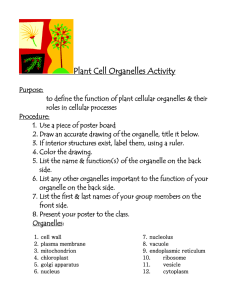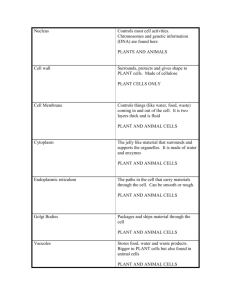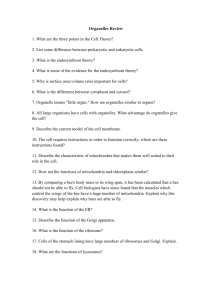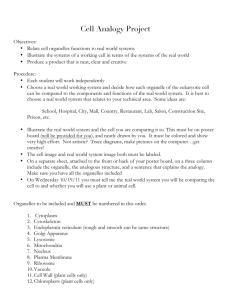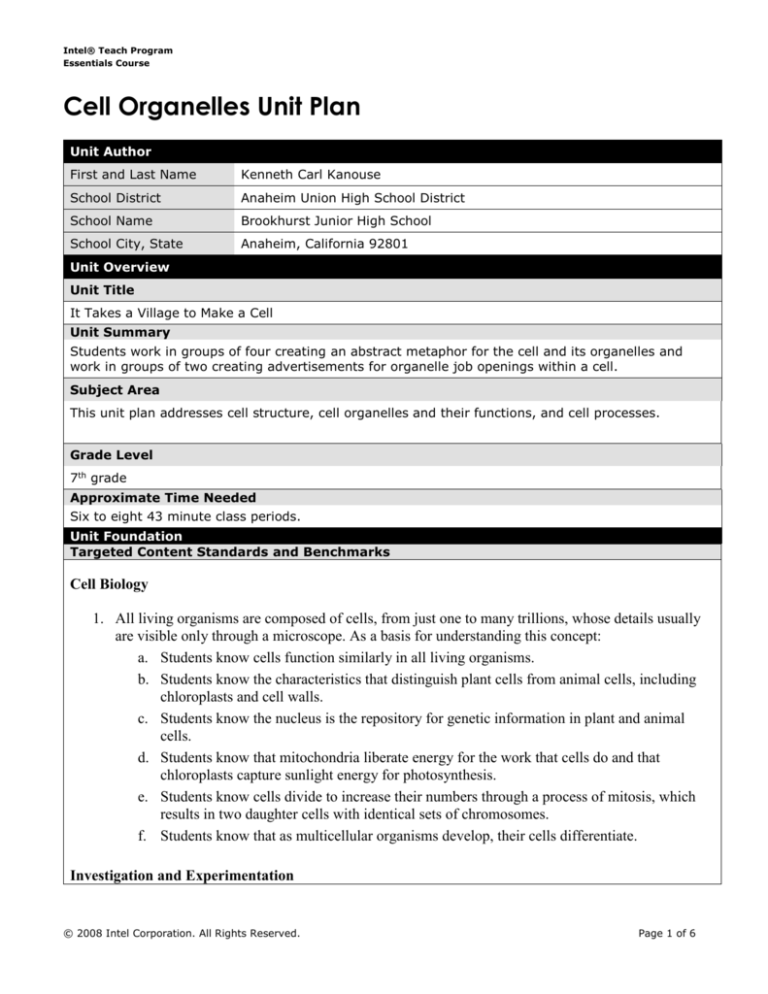
Intel® Teach Program
Essentials Course
Cell Organelles Unit Plan
Unit Author
First and Last Name
Kenneth Carl Kanouse
School District
Anaheim Union High School District
School Name
Brookhurst Junior High School
School City, State
Anaheim, California 92801
Unit Overview
Unit Title
It Takes a Village to Make a Cell
Unit Summary
Students work in groups of four creating an abstract metaphor for the cell and its organelles and
work in groups of two creating advertisements for organelle job openings within a cell.
Subject Area
This unit plan addresses cell structure, cell organelles and their functions, and cell processes.
Grade Level
7th grade
Approximate Time Needed
Six to eight 43 minute class periods.
Unit Foundation
Targeted Content Standards and Benchmarks
Cell Biology
1. All living organisms are composed of cells, from just one to many trillions, whose details usually
are visible only through a microscope. As a basis for understanding this concept:
a. Students know cells function similarly in all living organisms.
b. Students know the characteristics that distinguish plant cells from animal cells, including
chloroplasts and cell walls.
c. Students know the nucleus is the repository for genetic information in plant and animal
cells.
d. Students know that mitochondria liberate energy for the work that cells do and that
chloroplasts capture sunlight energy for photosynthesis.
e. Students know cells divide to increase their numbers through a process of mitosis, which
results in two daughter cells with identical sets of chromosomes.
f. Students know that as multicellular organisms develop, their cells differentiate.
Investigation and Experimentation
© 2008 Intel Corporation. All Rights Reserved.
Page 1 of 6
Intel® Teach Program
Essentials Course
7. Scientific progress is made by asking meaningful questions and conducting careful investigations.
As a basis for understanding this concept and addressing the content in the other three strands,
students should develop their own questions and perform investigations. Students will:
a. Select and use appropriate tools and technology (including calculators, computers,
balances, spring scales, microscopes, and binoculars) to perform tests, collect data, and
display data.
b. Use a variety of print and electronic resources (including the World Wide Web) to collect
information and evidence as part of a research project.
c. Communicate the logical connection among hypotheses, science concepts, tests conducted,
data collected, and conclusions drawn from the scientific evidence.
d. Construct scale models, maps, and appropriately labeled diagrams to communicate
scientific knowledge (e.g., motion of Earth's plates and cell structure).
e. Communicate the steps and results from an investigation in written reports and oral
presentations.
Student Objectives/Learning Outcomes
Students know how cell organelles work independently and together allowing for proper cell function.
Students also know the characteristics that distinguish plant from animal cells.
Curriculum-Framing Questions
Essential
Does it take a village?
Question
Unit
Questions
How do cell organelles individually and together contribute to the success of a
cell?
Content
Questions
How do mitochondria provide energy for the cell?
Assessment Plan
Assessment Timeline
© 2008 Intel Corporation. All Rights Reserved.
Page 2 of 6
Intel® Teach Program
Essentials Course
Before project work begins
An initial student
survey through
Google. This will
give me
background
information on how
much prior
knowledge, if any,
the students
possess, regarding
the cell and its
component parts.
Student Survey
Total Physical
Response. I will the
students through an
initial introduction to
the cell organelles
using the “invisible
screen” and total
physical response.
http://spreadshee
ts.google.com/vie
wform?formkey=d
HNUTG1ocTlxTlJ
YcGR1YlNfbExR
N1E6MQTG1ocTl
xTlJYcGR1YlNfb
ExRN1E6MQ
Students work on projects
and complete tasks
Cell Organelle
Metaphor Group
Project. The
students will work
in groups of four
creating a
Powerpoint
presentation with 12
slides, with each
slide creating a
metaphor for a cell
organelle (eg: the
mitochondria are
akin to the gasoline
in a car—both
provide energy).
Cell Organelle
Song. Students in
groups of 2-3,
create a “Song”
incorporating all 12
organelles n the
lyrics. The song is
presented in class
(sung) with lyric
sheets for the other
students.
After project work is
completed
Cell Organelle
Haiku Poem
Slam. Students,
individually, create
five Haiku poems
summarizing the
five main
organelles
(nucleus,
mitochondria,
chloroplasts,
endoplasmic
reticulum, and
ribosomes). The
students then have
a Cell Poetry Slam
contest in class.
Cell Organelle
Employment
Newspaper Ad.
Each student picks
Five organelles &
create an ad in a
newspaper
for organelles to
fill work positions
in the cell. Each
ad will include a
job description for
the cell organelle &
job experience
and requirements
for the cellular job.
Peer Grading Rubric
Student Rubric
Assessment Summary
The unit will begin with an online survey to determine students’ level of prior knowledge. I will then
proceed to total physical response as I introduce the cell organelle vocabulary along with an ancillary
vocabulary word wall (on the front board). Direct instruction and a series of interactive notebook
assignments will be used (eg: Costa’s Questions, notemaking of text readings, Cornell Notes,
Matchboxes, Nonlinguistic representations) to assess the students’ broad understanding of the topic
prior to the project. The Group project will require the students to use their abstract thought abilities to
© 2008 Intel Corporation. All Rights Reserved.
Page 3 of 6
Intel® Teach Program
Essentials Course
create a metaphor for the cell (eg: A cell is the same as a train). The students will then create a series
of powerpoint slides showing how all the organelles of a cell can be represented by parts of a train (and
explain how each part works in a metaphor-analogy sense). This presentation will allow the students to
think about the material at a great depth and in a critical thinking way. After the group project is
completed, the students will summarize their learning utilizing two creative outlets—the organelle song
and the Organelle Haiku Poem Slam Contest. For the Organelle Song, the students in pairs, will use the
melody of well-known song and change the lyrics so the song about the organelles (I will show them a
song I wrote about the organelles using the song “There’s Something Happening Here”. After the
students create and perform their songs, they will then create 5 Haiku Poems for five different
Organelles. A Organelle Haiku Poem Slam Contest will then take place in class. For both of these
activities, students must have mastery of the subject matter in order to complete them. Finally, the
students will create newspaper job ads with the job requirements to hire organelles for a cell.
Unit Details
Prerequisite Skills
Regarding technology, students must be proficient on powerpoint and researching the internet using the
main search engines. They must be able to access Google, set up a powerpoint and be able to work on
the slides in a group setting both individually and together. In addition, they must possess a modicum
of group skills so they work harmoniously with their group members, share information and present
together (some oral speaking skills are also necessary.) Regarding the content information, the
students must know the basic information about the main cell organelles and what function each
performs for the cell.
Instructional Procedures
The students are introduced to the topic of cell organelles through text reading, notemaking and TPR
(Total Physical Response). After the students have gained an introductory knowledge of the subject
matter, they are given the opportunity to think in an abstract way about the topic through the use of
metaphors within a collaborative framework. The students are then given two opportunities to
summarize what they’ve learned about organelles (which also serves as an assessment) through the use
of cell songs and haiku poems. The final capstone project is the pairs project where the students use
their knowledge of the function of various cell organelles to create advertisements for job openings for
various organelles inside a cell.
Storyboard
Directions for Org
Project
PPT student
sample.ppt
Accommodations for Differentiated Instruction
Special Needs
Students
RSP and Special Day students can use this unit plan without a great deal of
modification. In order to maximize its efficacy in this educational arena the
powerpoint project should be reduced to five primary organelles: nucleus,
mitochondria, chloroplasts, endoplasmic reticulum and ribosomes (instead
of working on all twelve). The nice thing about this unit is that it has a
large number of visual pieces which work well in special ed.
© 2008 Intel Corporation. All Rights Reserved.
Page 4 of 6
Intel® Teach Program
Essentials Course
Nonnative
Speakers
Gifted/Talented
Students
It is imperative that when the student groups are created for the cell organelle
powerpoint group presentation that non-native speakers are paired with the group
members that are English proficient speakers. A reduction in the number of
organelle terms might be also in order for a sheltered class.
It would be a good idea for these GATE students as a group to write a song about
the cell organelles post powerpoint, and then sing their song to the class…or create
a rap.
Materials and Resources Required For Unit
Technology – Hardware (Click boxes of all equipment needed)
Camera
Laser Disk
VCR
Computer(s)
Printer
Video Camera
Digital Camera
Projection System
Video Conferencing Equip.
DVD Player
Scanner
Other
Internet Connection
Television
Technology – Software (Click boxes of all software needed.)
Database/Spreadsheet
Image Processing
Web Page Development
Desktop Publishing
Internet Web Browser
Word Processing
E-mail Software
Multimedia
Other Google / Powerpoint
Encyclopedia on CD-ROM
Printed Materials
Prentice Hall 7th Grade textbook
Supplies
Computer lab or a COW (Computer on Wheels) is critical to be able to
access.
© 2008 Intel Corporation. All Rights Reserved.
Page 5 of 6
Intel® Teach Program
Essentials Course
Websites
1)
www.schools.manatee.k12.fl.us/072JOCONNOR/celllessonplans
(How to set up and conduct a microscope lab for the cell.)
2)
www.lessonplanspage.com?ScienceJH.htm
(A 50 min cell lesson plan using technology.)
3)
http://cellsalive.com?cells/cell_model.htm
(This in an interactive Animal and Plant Cell Wecsite. Where students can see cell
organelles in action—and manipulate them).
4)
www.teachersfirst.com?winner/cellparts.cfm (group project having students
create want-ads for organelles in a newspaper).
5)
www.accessexcellence.org/AE/AEC/AEF/1996/Calo_cell.php
(Group project for students using cards to indentify cell
organelles in plants, animals and bacteria.)
6)
Internet Resources
http://education.sdsc.edu?download/enrich/cellstudy
(Picture diagrams of the cell where parts of the organelles
can be deleted or added – along with their definitions.)
7)
http://education.sdsc.edu?download/enrich/cellstudy
(Picture diagrams of the cell where parts of the organelles
can be deleted or added – along with their definitions.)
8)
http://www.bibiblio.org/virtualcell/
(A website where students can take a virtual tour of a plant
and animal cell.)
8) www.lessplansinc.com/biology
(A cell membrane lesson plan involving the cheek cell.)
9) http://science.howstuffworks.com (a video on how Red Blood Cells work and
reproduce—interactive and includes mitosis)
10 http://www.teach-nology.com
(Plant and animal cell worksheets that can be downloaded).
Other Resources
Copyright © 2008 Intel Corporation. All rights reserved. Intel, the Intel logo, Intel Education Initiative, and Intel Teach Program are trademarks
of Intel Corporation in the U.S. and other countries. *Other names and brands may be claimed as the property of others.
© 2000-2007 Intel Corporation. All Rights Reserved.
Page 6 of 6


